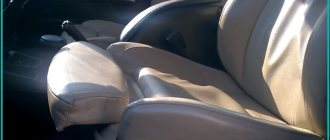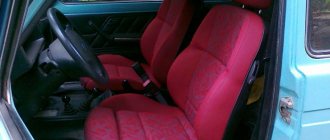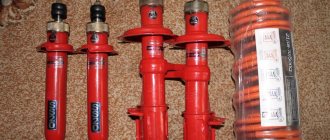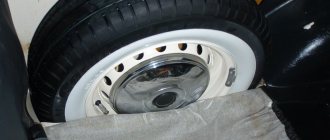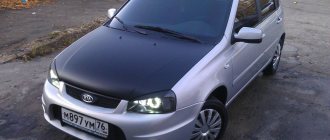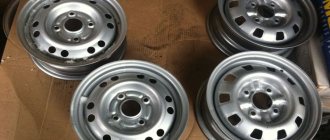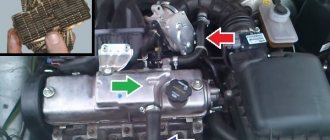Lada Kalina Sport
At first glance at the Lada Kalina, one cannot say that it is distinguished by a special bright design aimed at attracting mass consumers in a competitive environment. This is the image of a car, the assembly and design of which corresponds to a more classic style. The designers set themselves the task of creating a car with new capabilities for everyday use that could appeal to both the male and female segments of the population, and of different age categories. To do this, they decided to improve the popular Kalina sports version. Of the many changes to the car, tuning also affected such important elements as the Kalina Sport seats.
Features of the Sport model seats
In order to ensure a level of quality that complies with the standards established in Europe, it was necessary to follow all safety requirements. To protect against corrosion phenomena, thirty-three new materials were used in the structural design of the Lada Kalina Sport:
- metals;
- different types of plastics;
- paint and varnish materials;
- new compounds for gluing.
For the Lada Kalina Sport, a sports-type suspension was developed with an original spring, shock absorbers, struts, and upper supports of the front struts. Disc brakes are installed, and the front ones are equipped with larger-diameter discs. In addition, the model received bumpers of a different design, unusual door moldings, an upper rear door spoiler, sports pedal pads, and new alloy wheels.
The car has disc brakes
Other changes to Kalina Sport include better corrosion resistance, which is ensured through the use of galvanized parts using painting technologies. The design of the body and every detail in the interior was carried out by introducing mathematical modeling methods.
This made it possible to optimize the rigidity and reliability characteristics of the vehicle and increase the quality of the interface of each body part from the outside. The most modern types of equipment and technologies were used in the production of Lada Kalina. During the welding, 360 robots were involved. The painting process is carried out with absolute automation.
Assembly is carried out in modules according to a specific scheme. At the end of any assembly line, quality control is carried out using computerized stands.
Modernization of interior and seats
OJSC AvtoVAZagregat produces and supplies seats for any VAZ model, including Lada Kalina Sport cars. A wide range of materials are used for seat upholstery with a different range of colors. The design of the seat includes a metal frame, which is made by welding, and padding elements, in the production of which elastic polyurethane foam is used. Textiles or artificial leather are used for upholstery. Specialists from AvtoVAZagregat OJSC have modified some elements of the Lada Kalina’s interior.
- Now, in the production of seats, components of Russian and foreign production are used. Lada seats are distinguished by innovative padding and more pronounced lateral support. They have become much more comfortable, safer and meet standard requirements.
- Pedal pads 11196 Sport 1.6L 16V are supplied as standard equipment for a VAZ car. A thick layer of polished stainless steel also has rubber inserts. They are fastened without drilling or riveting, using special clamps with bolts.
- The salon is distinguished by the dark graphite color scheme of the instrument panel and other interior elements. The luxury package includes a climate system and a number of other options provided for it.
Advantages of seats in Lada Kalina Sport:
- the design solution in the layout plan made it possible to optimize the area of the internal space;
- the seating height can provide sufficient visibility;
- the chairs are comfortable and ergonomic;
- large angles when opening doors adds convenience when passengers enter/exit;
- the rear seats can be adjusted to accommodate a variety of cargo sizes;
- The presence of glass with athermal properties can protect the car interior from seat burnout and interior overheating, and the luxury version of the model is equipped with a front seat heating system.
Due to the fact that modern materials are used in the Lada Kalina, the car's sound insulation is good. They are also currently developing seats for the Sport model, covered in artificial leather with performance characteristics corresponding to high-quality German-made samples.
In addition, the rear seats for the Lada Kalina car were designed using L-shaped headrests, which passed homologation testing at UTAK, in France. A project with seats for the Lada-2190 is at the development stage. The assembled seats are capable of withstanding 80,000 kilometers of testing for the condition of structural connections and installation.
During the installation of the seats, all safety requirements were met in accordance with UNECE rules No. 14,21,94,95. The warranty period for using car seats corresponds to the warranty period for the car.
Volume and features of the trunk of Lada Kalina: station wagon, sedan and hatchback
Lada Kalina is a budget B-class car developed by AvtoVAZ in 1993. The car received its name, which became a recognizable trademark, in 1998. During the period from 1999 to 2001, modifications were developed in hatchback, sedan and station wagon bodies.
All body and power unit configurations were built using innovative computer technologies and were put into mass production in 2004. On the Internet you can find both positive and negative reviews about the Kalina 1 model; there are also controversial opinions about the carrying capacity parameters and trunk volume of the Lada Kalina station wagon, hatchback and sedan.
Lada Kalina hatchback
The body version of the Lada Kalina hatchback was launched into production in 2006 and was produced without modernizing the power unit or changing the interior for 7 years. In 2013, production of the second generation hatchback was launched. Speaking about capacity and total carrying capacity, let's consider the dimensions:
- length 3850 mm;
- width 1700 mm;
- height 1500 mm;
- ground clearance 160 mm.
With such dimensions, the hatchback has a relatively good trunk - its volume in liters is 240. If you fold the rear seats, the capacity can be increased to 550 liters.
Main dimensions: 94.7x64.4x49.2 cm.
With such modest dimensions, Kalina has a fairly impressive carrying capacity of approximately 500 kg (this takes into account the presence of 4 adult passengers in the car). The car meets the requirements for family cars: cross-country ability, safety, passenger comfort, acceleration dynamics, etc.
In addition to the classic hatchback VAZ-1119 Kalina, an off-road, sports version of the Lada Kalina Cross was also produced, as well as 2nd generation hatchbacks (VAZ-2192). Let's take a look at their cargo compartments:
- The trunk volume of Kalina Cross is 355 liters.
- Trunk Kalina 2 - 240 l.
Lada Kalina station wagon
This version of the VAZ-1117 has been produced since December 2007 and immediately became the leader in the Kalina line in terms of load capacity:
- length 4040 mm;
- width is 1700 mm;
- height is 1500 mm;
- vehicle clearance 160 mm.
The trunk size of the Kalina station wagon is 355 liters, and with the passenger seats removed this figure can be increased to 670 liters.
Its main dimensions are as follows:
- width – 1 meter 34 cm;
- length (depth) – 80.6 cm (to the backs of the seats);
- height – 52 cm.
The second generation station wagon VAZ-2194 has similar body dimensions and similar cargo compartment dimensions. Depending on the type of interior finishing, the trunk may be 10 liters more or less.
Trunk Kalina sedan
The configuration in this version is the first model whose dimensions were calculated by a computer program. The model has been produced since 2004. The sedan's dimensions are similar to the station wagon, but due to the difference in design types, the sedan's interior seems more spacious:
- length 4040 mm;
- width 1700 mm;
- height 1500 mm;
- vehicle clearance 160 mm.
The trunk of the sedan is 400 liters. This figure can be increased by folding the passenger seats. Trunk volume Kalina sedan:
- trunk width – 97 cm;
- height – 51.5 cm;
- diagonal – 97 cm.
The sedan has a fairly spacious interior and a roomy trunk, although it is not specifically designed for transporting large cargo. You cannot put large items in the trunk, but it is easy to transport luggage up to 500 kg.
Features of luggage racks
Cargo compartments for Lada Kalina vehicles have some special features. They must be taken into account by motorists who choose equipment for specific transportation conditions:
- Increasing cargo capacity due to the folded rear passenger seats of the Lada is much easier and faster than similar cars in this class.
- The luggage compartment lid rises 60 cm higher than on models in similar classes. This is quite convenient for frequent loading and unloading of Kalina.
- It is possible to install an additional non-standard roof box for transporting things. Kalina's load capacity increases by 40% if you use lightweight roof racks consisting only of crossbars and the main unit.
In addition to the advantages that the equipment has, there are also problems that are noted by owners of two- to three-year-old cars:
- At temperatures below 15 °C, frequent breakdowns of the shock absorber of the cargo compartment door are observed.
- Car enthusiasts note problems with the lock in the hatchback configuration in the second year of operation. The lock breaks, the cylinder falls out or the spring stretches, and in some cases the locking ring gets jammed. The lock has to be changed.
Initially, this AvtoVAZ line was planned as small family cars not intended for transporting goods. Hatchbacks have the smallest trunk; when transporting even small loads, you have to wisely use every centimeter of it, saving space. If you need a car specifically as a cargo carrier, we recommend choosing the station wagon option. Its cargo space is enough for family trips to the country, picnics and wholesale stores.
Purchase and installation of new seats
From the very first days of car operation, standard-type seats were not particularly satisfactory for vehicle owners. The seats were very soft, you could literally “sink” into them when you sat down, and the quality of the upholstery left much to be desired. The seats on the Kalina Sport were a completely different matter. At first, seats for the sports version of Kalina were produced by the famous German company RECARO GmbH & Co. KG.
The price for one seat was more than 10,000 rubles. Most recently, they were able to master production at AvtoVAZagregat OJSC in the city of Tolyatti. You won’t be able to find such seats in retail, but you can buy them directly at the factory. The estimated price is from 14,000 rubles for two front seats. The downside is that there is no delivery, and you can only pick them up directly at the enterprise, which is not entirely convenient.
As a result of the unification of the Kalina and Granta bodies, the attachment points for components and elements are in many ways similar. The same can be said about the seats. The process of removing the front seats is extremely simple.
- Sit in the front of the car and move the seat back as far as possible, lifting the lever to do this. As a result, access to the skid mounting bolts from the front will open. The bolts should be unscrewed.
- Next, you need to move the seat forward all the way, unscrew a couple of bolts securing the slide at the back. The seat can now be removed.
The seats on the right and left sides of the front detach in the same way. Removing the rear seat.
- To remove the rear seat cushion, you will need to pull the tab and fold it out. At the bottom, the pillow brackets are secured with stops. Pull them towards you and remove the pillow. If the rear seat is of a split type, then the principle of removing the cushions of the two halves is the same.
- Next, remove the seat back. First of all, press the backrest lock handle and tilt it forward.
- Several backrest fastening nuts will be visible from the luggage compartment of the car. Unscrew them and remove the proper backrest (with a split rear seat). If you need to remove the mounting brackets, you should unscrew the corresponding bolt with which they are secured.
This completes the steps to remove the backrest and rear seat cushion. Features of installing seats front and rear: each seat is installed in the opposite order of removal. When installing the slide at the front, the rubbing parts can be lubricated using Fiol-1. Thus, there are no significant features for dismantling the seats.
In the Lada Kalina, the updated seats have a more developed profile, and in the “luxury” configuration it is possible to adjust the height of the driver’s seat.
How to fold out the back seat of a Kalina station wagon
In addition to the driver's door stop falling off, this is the second jamb my car has had during its entire operation. There was no desire to go under warranty because of this.
So. In the Kalina, the seats fold out into 2 parts - the left and middle passenger seats are in one piece, and the right one is single in the other. Due to the fact that after the purchase, the seats did not have to be completely folded out, this jamb did not catch my eye. The essence of the jamb is that the rear right seat cushion stupidly did not recline forward due to the fact that it is held by a hook from below,
I solved this problem simply. First, I unscrewed the screws holding the seat itself, took it out somehow, and then stupidly sawed off this very hook with a grinder.
Colleagues, good day! I actually asked the question on the Kalinoforum, but it’s so quiet there that you can hear it rotting right now
For those who are unable to follow the link, here is the text:
In “chisels”, and in particular in the VAZ 21099, which I used from 2003 to 2011, the front seats could be folded forward, with a slight movement of the hand, picking up the hooks at the base of the backrest. This very useful artifact remains from the “eight”, only the trigger has disappeared from the upper part of the back. And by removing the headrest and folding the back of the navigator's chair, it was possible to stow cargo that was not quite large in size into the cabin.
In this regard, the Kalina station wagon opens up generally tempting prospects - by unscrewing two nuts by ten, removing the small rear seat cushion, folding the small backrest, deepening or removing the headrest of the front seat (the navigator's seat) and folding it forward, we would eventually get space for cargo the size of a small closet! 2.4-2.6 m long (need to double-check locally), 0.5-0.6 m wide and about the same height (0.5-0.6 m), so as not to block the right mirror. But alas, the back doesn’t fold!
The question is - what needs to be done and, most importantly, how to ultimately get such a useful option for transforming the interior?
What prevents you from twisting the back into a lying
! There will be no rear seat cushions.
This is how I transported the sofa - like this
in one trip.
PS 2.6 m - softened - but 2 will fit diagonally to the dashboard.
Hatchbacks Lada Kalina, Lada Samara, Lada 112. A look at the back
LADA > Kalina
LADA KALINA (VAZ-11193)
Five-seater 5-door hatchback. Body options: sedan, a station wagon is also being prepared.
Engine: 8-valve petrol 1.6 l (81 hp) with distributed fuel injection.
Transmission: 5-speed manual. Drive is on the front wheels.
Options: “standard”, a little later - “luxury”.
Expected price: $8620 (250 thousand rubles)
Five-seater, 5-door hatchback, serial production began in 2000. Body options: sedan, station wagon, coupe.
Engine: since October 2004, a 16-valve petrol 1.6 liter (89 hp) with distributed fuel injection has been installed.
Transmission: 5-speed manual. Drive is on the front wheels.
Options: “standard” and “luxury”, additionally power steering and air conditioning.
Price: $8520 (247 thousand rubles)
The five-seater 5-door hatchback has been in serial production since 2003 to replace the VAZ 21093. Body options:
3-door hatchback, sedan.
Engine: 8-valve petrol 1.5 l (77 hp) with distributed fuel injection.
Transmission: 5-speed manual. Drive is on the front wheels.
Options: “standard” and “luxury”.
Price: $7240 (210 thousand rubles)
In 2004, Lada Samara 2 replaced the first generation cars on the assembly line. Prototypes of the 2113 and 2114 hatchbacks received a fifth door that extends to the bumper—this trunk is much more convenient to use. During testing, another advantage emerged - due to the rounding of the “back part” of the rear, the glass remains clean even in slush! Unfortunately, for the sake of economy, the “old” door was used in the series.
The "tenth" family - essentially a further development of "Samara" - is devoid of many of its shortcomings. Undoubtedly, the Lada-112 looks more elegant and modern than the fourteenth and the quality of the bodywork is higher.
If we, without a doubt, classify the “fourteenth” and “twelfth” as hatchbacks, then this “Kalina” is perhaps closer to station wagons. At least her "back" is not a "hatch" at all.
The latest model “Kalina” is already a modern car of European level. At least externally, in terms of the size and uniformity of body gaps, it is almost inferior to most of its foreign classmates. The interior matches the exterior - elegant and ergonomic.
EIGHT AND SIXTEEN
The VAZ 2111 1.5-liter eight-valve injection engine provides the Samara with good dynamics and moderate fuel consumption. Well, they inherited good handling from the first generation.
But it is unlikely that the manufacturer will ever offer power steering, ABS, air conditioning or airbags to the owners of these cars, even as options.
The front seats of all three hatchbacks are approximately the same in terms of comfort and living space, except that the interior of the Kalina looks more fresh. However, the latter is a matter of taste
The base engine of the “twelve” is a sixteen-valve engine, the volume of which has increased to 1.6 liters since last year (ZR, 2004, No. 12). The old one and a half liter Lada-112 also provided excellent dynamics, but with the updated one, thanks to better elasticity, it became easier to get underway, and while driving it is possible to change gears less often. Owners will be pleased with low fuel consumption, good smoothness and relatively low noise, but with vibrations, alas, the situation is somewhat worse.


